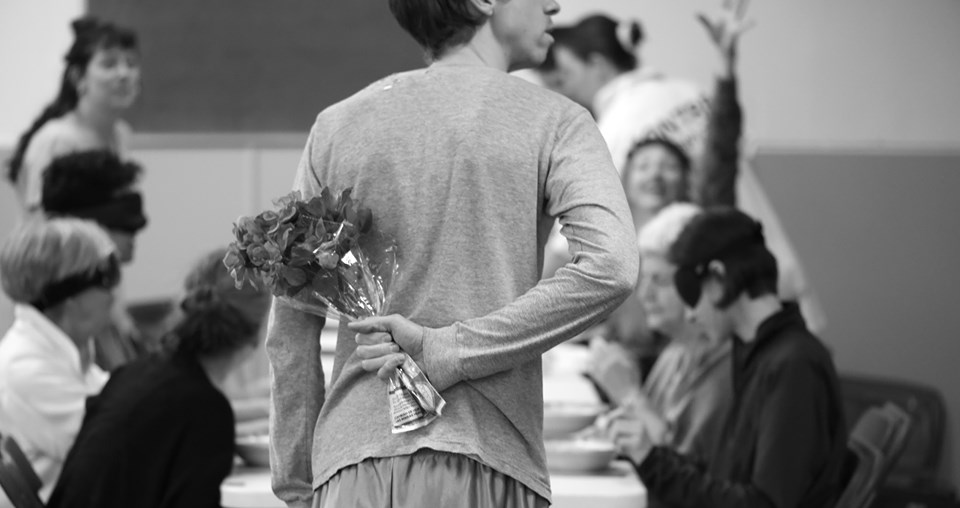Art is and, for the most part, always has been a feast for the eyes. It is delightful to look at a painting and recognize the emotion in the subject’s facial expression, to experience a multicoloured light show at a concert, and to watch costumes glittering as dancers sway and leap during a performance. But what if you could not see? How does one experience art if they cannot see?
This is a question that Audrey-Anne Bouchard wants to answer. Bouchard is a multidisciplinary artist, performer, and professor at Concordia and the National Theatre School of Canada. Her latest show camille: un rendez-vous au délà du visuel is currently being presented at Montréal, Arts Interculturels (MAI) in the Plateau.
“I asked myself, what do people who cannot see at all retain from a dance performance or theatre?” said Bouchard. “They were telling me that they are always aware that [they are] missing a part of the show, so I came up with the hope of creating a piece where they wouldn’t be missing anything.”
camille: au délà du visuel, a performance piece which tells the story of a loss of friendship, aims to create an immersive, multi-sensory experience.
“I knew from the very beginning that [the show] was going to be immersive,” said Bouchard. “For me, it meant that the spectator would be immersed in the set of the piece; they would be able to understand through space, touch, sound, and texture, the environment in which it takes place.”
Inspired by her own disability, Bouchard created au délà du visuel, or beyond sight, a project aiming to enable a new audience-one who normally wouldn’t be able to access theatre and dance shows-to experience performance art.
“[The loss of my eyesight] came very progressively,” explained Bouchard, who suffers from Stargardt’s disease. “I started losing sight when I was around 17 but it took several months before they could find out what the origin of the problem was.”
Bouchard, who has always worked within the performing arts, noted that it only occurred to her about 10 years after the fact that her practice is very visual.
“It’s interesting because I created a job for myself where I can work with my eyes closed; I created a context where my disability is not a disability at all,” she said. ‘“I did a lot of research on the visual aspect of theatre and dance and I realized that this is kind of a paradox, that I’m losing sight and working with such a visual discipline.”
This inspired Bouchard to further her research and discover what it is that artists share through their art that does not necessarily have to be shared through sight.
“It was obvious then that the piece had to be immersive,” explained Bouchard. “To share with people, I need to be close with my performers.”
camille: au délà du visuel allows for the spectator to be fully immersed in the set, alongside the performers. Blindfolds are required for those without any visual impairments and audience members are directed through the performance, through touch, music, and narration.
“We also welcome people who have different kinds of disabilities,” said Bouchard. “We can guide you through a show if you’re in a wheelchair.”
Bouchard noted that the distance between the stage and the audience is what makes performance art very visual, by default.
“If we eliminate that distance then we have access to all of [the spectators’] tools,” she explained. “[We had to find out] how can you share the performance of an actor when you don’t see him.”
The development of the project took over three years and was very theoretical. “We created a new creative process methodology with this project,” Bouchard said. Through working with people who are visually-impaired and through research, Bouchard created a new way to work.
This new process methodology inspired Bouchard and the team of performers and artists she works with to develop a series of workshops.
“We designed a workshop to teach students or other artists how to work that way,” Bouchard said. “I think that now we have to keep working and creating work altogether for an audience living with visual disabilities and other disabilities that we would like to address as well.” Bouchard’s workshops, which will be both interactive and theoretical, are in the works and will be further developed over the course of the upcoming year.
“I see a desire from the arts consult to encourage more accessibility […] to all kinds of audiences who don’t normally have access to the arts,” said Bouchard. “It is becoming more and more present, and it’s changing. I’m benefiting from it, but I’m also hoping to help make it happen in the future; I hope that my work is also a great example of how the creative process that we use everyday works, but that there are so many other ways to create art that can be explored.”
camille: un rendez-vous au délà du visuel is being presented until Sept. 22, at Montréal, arts interculturels, at 3680 Jeanne-Mance St., suite 103. Further details regarding showtimes can be found at www.m-a-i.qc.ca
Photos courtesy of Laurence Gagnon Lefebvre
